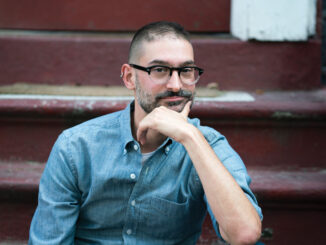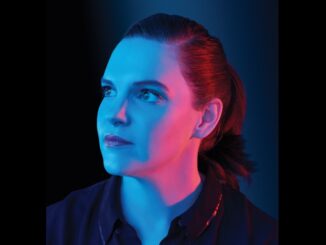
By Rob Feld
For editors Garret Donnelly and Geofrey Hildrew, ACE, helping make Netflix’s “Painkiller” was a process of uncommon exploration. The miniseries, directed by Peter Berg, explores the characters and events around Purdue Pharma, the company behind the now-notorious opioid drug OxyContin.
Lifting the curtain on the Sackler family behind Purdue, “Painkiller” examines America’s opioid crisis and the government investigation through a melding of fact and fiction. Through a frequently hyper-real narrative, the miniseries tracks many characters and moves back and forth through time. The editors could lean on the character of U.S. Attorney Edie Flowers (Uzo Aduba), a composite character that could help root the audience.
Based on the book “Pain Killer” by Barry Meier and the New Yorker article “The Family That Built an Empire of Pain” by Patrick Radden Keefe, “Painkiller,” which premiered in August on Netflix, centers on Richard Sackler (Matthew Broderick), the prosecutors investigating the emerging opioid crisis, victims of the drug, and a healthcare system that failed to see until too late what was happening. To achieve Berg’s vision, the editors had to throw away the rule book.
CineMontage: This is a tonally unique series, and I would imagine challenging to talk about with collaborators before you have something to see. What were you told when you were hired?
Geofrey Hildrew: Peter [Berg] was open-minded when we started the project and wanted to see what we wanted to bring to it. He had this ongoing mantra to be fearless. He didn’t want it to be a traditional TV show—he wanted us to challenge him and come up with unexpected ways to present the material. Pete has different areas of expertise as an actor, a film director, a documentarian, and a commercial director. He brought a lot of those styles to this project and gave us a sandbox to play in to see what we could do.
Garret Donnelly: We embraced it and would experiment in many different ways, but it was clear when seeing his dailies that it wasn’t going to be a conventional TV show. He kept the camera rolling and would move from setup to setup, so it wasn’t traditional coverage. We wouldn’t get a shot over here to match a shot over there. Maybe he’d move into 50/50 or a profile shot. So it kept us on our toes and have to organize a lot more than we would on other shows. But because he kept cameras rolling, you could hear him giving direction so we could still get a feeling for what he was going for. He also did a lot of improv.

CineMontage: Can you give an example?
Hildrew: Pete started out as an actor, so I think he approaches material from that mindset. While shooting, if he responded to a moment or if someone surprised him, sometimes he’d stop and encourage it, which could get unexpected and surprising results. We’d get dailies and there’d be a conversation about something that had seemingly nothing to do with the scene, but then you’d get an unexpected reaction that at first you would think would be impossible to use, but as you got into it, you saw the brilliance of Pete and how using it could create a much more dynamic, interesting character than we could possibly have hoped for. There’s an instance in Episode Three when Edie [Uzo Aduba] and Brownlee [Tyler Ritter] show up to the Purdue headquarters to have their first big meeting. Pete brings his dog Esso with him everywhere he goes. When we got the dailies, Esso was playing and barking in the background the entire time. I wondered how I was going to make that work and clean up the audio. But at a certain point, I just embraced it and it ended up being the inspiration for this intercut of this dog’s barking in the background while this important meeting is going on. And then Pete had the idea of having Richard Sackler throwing this tennis ball back and forth in the lobby while this is going on. It all created this weird energy and disrespect for something so important, and said so much about character. Pete had a specific plan but was trying to create an experience of each moment. It would give Garrett and me ideas to bounce off and pursue down our own rabbit holes.
CineMontage: How were you communicating with Berg during all of this experimentation?
Donnelly: Covid was still going on with all those protocols, so we were cutting from home. Geof and I would talk back and forth and get texts from Pete every once in a while saying, “Hey, check out this show.” He mentioned “Snabba Cash” to me once, which was great: Keep the cuts unexpected, the dialogue overlapping. We would try to communicate with them as much as possible, but we were going through all the footage ourselves, figuring out on our own, too. What voice did this show need?
CineMontage: Did you split up episodes?
Hildrew: I cut the odd episodes and Garret cut the even ones. Each episode in a great way has a unique feel, style, and tone to it, all within the language of the show. That gave us a lot of creative freedom to try things within our individual episodes. Every once in a while, Pete would improvise a scene on set that wasn’t scripted, so we had a handful of scenes at the end of the show that didn’t have an intended place. So, Garret and I had an ongoing dialogue around those, trading them back and forth.
CineMontage: There was a lot of ground to cover in this story. Was the great narrative challenge for you?

Hildrew: You’ve got a lot of characters and a lot of time periods we’re jumping through. The biggest luxury was to have the Edie storyline during the deposition as our throughline. We knew that whenever we needed to ground the audience and bring us back to the present-day storyline, we could latch onto Edie. We had some concerns that audiences might have trouble tracking where we were at and who we are with at different points. We experimented with things like chirons, timelines, and location banners to help orient the audience. But when we started screening it, we found that the audience was so invested in the characters that they didn’t care. They were on the ride.
Donnelly: We feel what Edie is going through, which helped ground it for the audience. Sometimes we pushed the boundaries with more satirical moments, but it was important to then bring it back to the heart of the show, which is the people who suffered through this tragedy. Edie helped guide us through that.
Hildrew: The subject matter is very serious and important, but we wanted to make sure that we were presenting the show in an entertaining way so that people could digest it. There were moments where it got too light and too fun, when we had to steer things back to a place that more informed by how we wanted people to feel about these characters and the story. It was okay to let the Sacklers be a circus act because maybe that said something about their character. You want to be disgusted by them a little bit. But when it got a little bit too frivolous, we reined it in.
CineMontage: It’s interesting to see how flexible you can be tonally and stylistically in one piece and how an audience can accept what you throw at them.
Hildrew: Pete was a very great partner, in that he was not ever afraid to push us too far. Whenever we thought we had pushed something to the brink of falling apart, oftentimes he’d push us even further. But he had a very good governor for when it got to be too far. That trust helped us land in a happy medium that still pushed the boundaries and kept us in an unsafe-safe place.
Donnelly: It was great to be able to explore all this footage and figure out different ways to tell this story while incorporating music in ways I hadn’t done in the past. The important takeaway for me was making scene individually an experience and then making that collective experience flow together for the audience.
Hildrew: Whether we were playing with a dramatic or serious tone, doing stylized music videos, cutting intimate dramatic scenes, or experimenting with music or chirons and graphics, there was not an editorial muscle that went unexercised, going through this process. It stretched our skills as editors and I think made us better. I can’t imagine having a creative experience like this again anytime soon.






